Our next day was one of travelling through wildflower country and the wheat belt. It is such a contrast from the wide open expanses of bush we had seen further north and inland.
As we left Mingenew, we notice the post office and visitors centre was in a nice old stone building. Even the tiny towns in the area have a visitors centre.
More public art. The development of laser cutting of steel had really helped create lots of art around the place.
What we have noticed is the varying length of road trains allowed on the roads. Whereas it was 60 metres in the mining areas, it was then reduced to 42 metres and here it was down to 36.5 metres. We were gradually getting less remote.
We noticed an old stone building on the side of the road with a rest area beside it, so went to have a look.
It is the Enanty Barn.
There were information boards showing how run down the building was before restoration commenced in 1994.
It is a credit to the team of volunteers. They don’t know if it was originally a shearing shed or grain storage.
Don’t you love the way the roof timbers were attached to the stone walls.
We were surprised that it is open to the public, free of charge and doesn’t appear to have been damaged in any way. A very nice thing to see.
Back on the road, we never tire of seeing the vast expanses of crops, all looking so good.
What we did notice, was the TALL trees. We have only seen short and stunted trees for a very long time, so this is a nice change of scenery,
As we travelled further south we started to see more windmills in use. This is a beauty, just before the little town of Morawa.
They even have them next to the sign to town. We learnt later that they feature at their museum and we didn’t have a look. Blast! We like windmills.
We are always amazed at the story behind little towns. Morawa was settled in the 1850s, with grain starting to be grown in 1910. The railway came through in 1913, just after the town was gazetted. It made history in 1966, when the first Australian iron ore was exported from a mine nearby. The mine closed in 1974, but has since reopened in 2010.
We were really impressed with the way the town looked. A town centre revitalisation project was undertaken and officially opened in 2015. The centrepiece is a stunning modern clock tower.
There are lots of road safety signs and banners, all created by the local school children.
Even the booth for street stalls has been made attractive.
Despite all this, there are still lots of empty shops, like all small towns.
The difference is that, rather than windows with stale displays or full of cobwebs, there have been historic photos of the towns applied to the inside of the glass and the windows are nice and clean.
We enjoyed looking at some historic buildings.
One place we were keen to visit was The Church of the Holy Cross, another of Monsignor Hawes’ creations, completed in 1934.
Inside was fairly simple, compared to the others we had visited.
You can see the Arts and Crafts movement influence on this grille.
What is unusual with this church is the little Priest’s Lodge at the rear of the church. The parish didn’t have a permanent priest, so this was considered sufficient for brief visits, in accordance with Father Hawes’ simple needs. It was probably not used very often and a presbytery was built in the 1940s, so it would have been made redundant then.
For such a tiny space, it is quite ornate and in quite a different style to the actual church.
The work involved in the domed ceiling would have been quite difficult, when a simpler options would have been available.
We had called in to the Visitors Centre in Morawa and been told where to find some more wreath flowers, so headed off in search.
The little dirt road isn’t marked as being a wildflower place, so we would never have found it otherwise.
They were located in a large clearing in the middle of nowhere, spread out over a wide area. It always amazes us how they grow in what looks like a very difficult location to survive. The best thing was that we were the only ones there for quite a while.
There were also some other flowers we hadn’t come across previously.
On our way back we stopped to enjoy some more drifts of flowers, They are so pretty.
The next town down the road was Perenjori.
There were more quirky steel cut outs representing various historic aspects of the district, mainly everyday things you tend to forget, like kids riding their bike to school, or the CWA cooking competition.
There was a path through the a park beside the railway that had been painted by school kids, depicting various things in the form of a time line. It was really colourful and would have been a fun way for the kids to learn their local history.
There is yet another Monsignor Hawes church in the town. THis one is St Joseph’s Church. It is quite different in style to the others we have seen. Unfortunately, it wasn’t open to the public.
An information board shows the building under construction and the original plans. It would have been nice to see the interior.
The cross appears to have fallen down from across the window above the door. It looks to need some restoration. Hopefully, that will take place soon.
The former Bank of New South Wales is now the Visitors Centre and little museum. We don’t tend to visit every museum, but we had a wander around and really enjoyed it.
We were both very taken with this green glass butter dish. We’ve never seen one like it and it would look very nice in our collection.
Wouldn’t this chest of drawers look nice in the sewing room. I’d easily fill them with bits and bobs.
It was nice to see some of the innovative bush furniture made from kerosene boxes.
With a bit of effort, they can be made very decorative.
Or more utilitarian for use in the shed.
Of course I’m always drawn textiles and sewing items.
It’s such a simple thing that would normally be long since thrown out, but the coat hanger on the right is even home made. Needs must. Also, imagine having to hand wash that woollen footy jumper on the left after a game in the wet. No thanks.
Outside there is a community garden and mural in the background.
The civic buildings were nicely presented.
This humble little monument in the park was placed to commemorate the connection of the town to a water supply in 1969. Such a simple thing that we take for granted, but would have made such a difference to people’s lives at the time.
On our way out of town we noticed their silos being prepared for this year’s grain crops.
Wubin is the next little town as we travelled south. We had another museum to visit.
This is the Wubin Wheatbin Museum, housed in the original wheat storage shed. Volunteers are there to provide information. It is a bit different to the current day silo complexes.
The walls are curved for strength.
It was interesting to see this photo of how the wheat was emptied into the wheat bin by a conveyor.
There was also a shed out the back with lots of vintage vehicles.
As the day was getting on we just drove through Dalwallinu. Unlike the other towns, there didn’t appear to be a lot to see there.
Finally, we arrived at Wongan Hills. This was a bit of a blast from the past for us. We had camped in the caravan park when we were over here in 1997 and had enjoyed a nice evening at the pizza cafe.
We arrived fairly late in the afternoon so just went for a walk up and down the Main Street.
There are some lovely old buildings and public art.
There was a section beside the road where some historic farm machinery was on display. It was interesting to read the stories. Here are just a couple.
It must have been hard work, mustn’t it.I’m so pleased that Ron’s tractor has been kept, as he was so innovative.
And that completed another day.
The highlight of the day was the was that the small towns were presented.









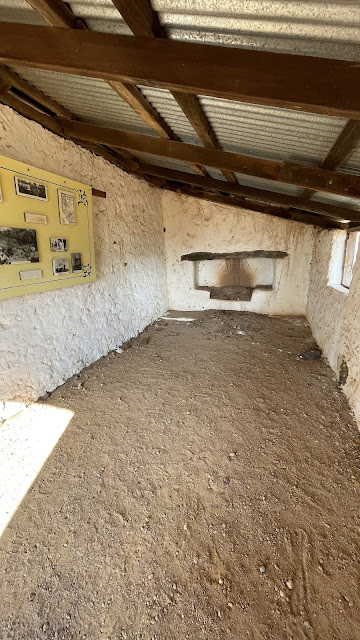
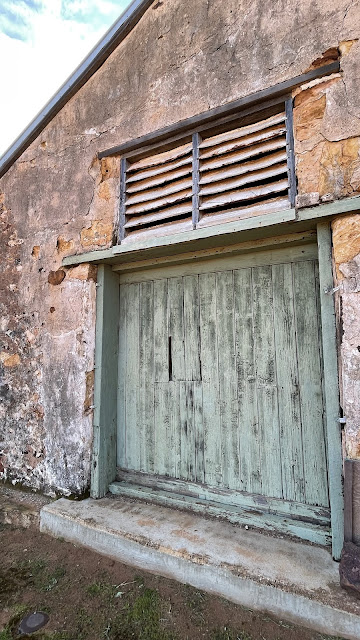
























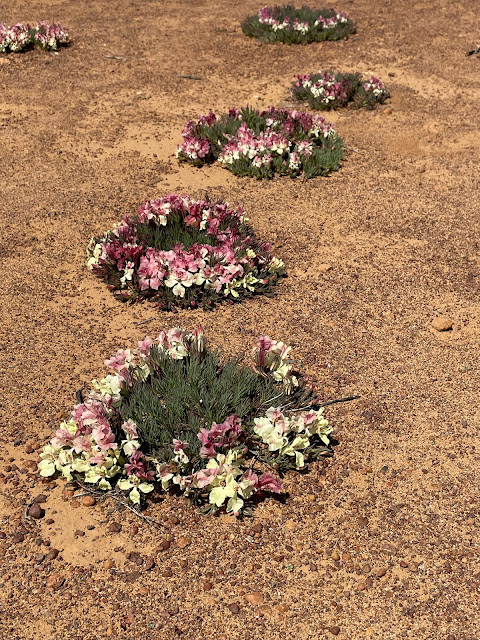










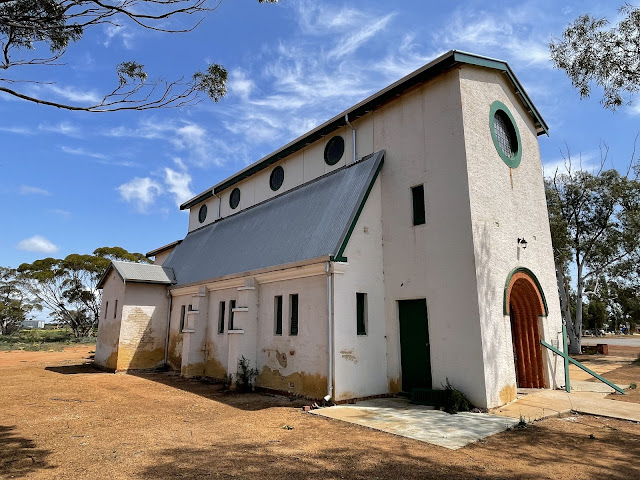



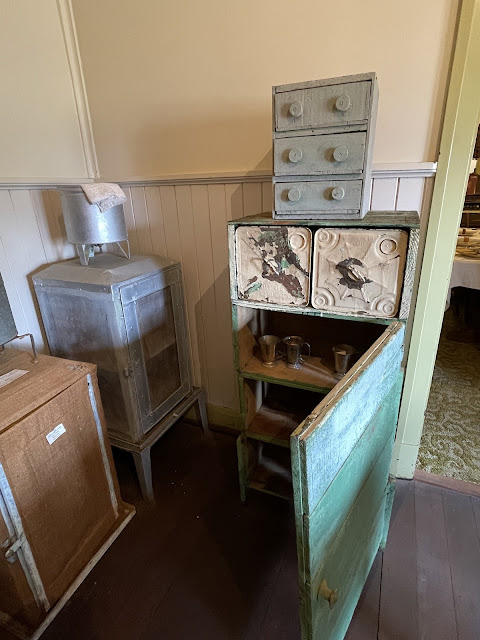


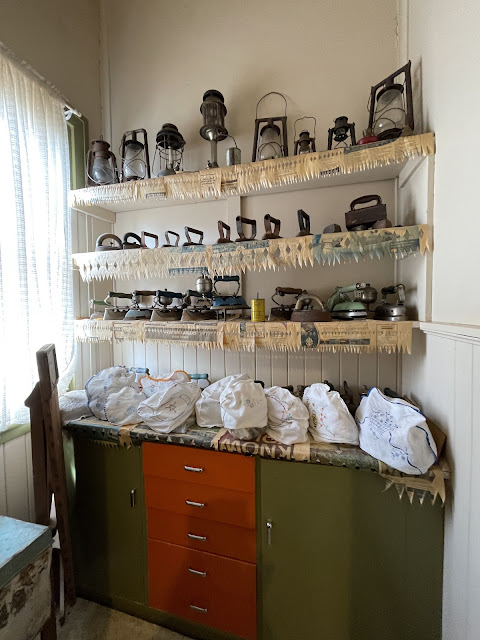
















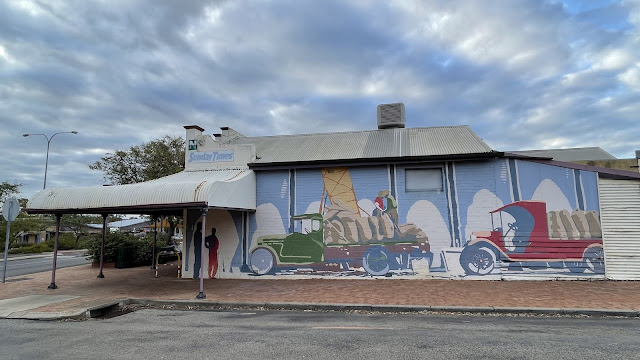






wow so many vintage items and even more beautiful flowers...i love the idea of filling the windows with vintage photos...and outdoor cut sheet metal art fascinates me...don't see that in new england where so many season changes...
ReplyDeleteAnother full on post with lots to see.
ReplyDeleteWow, that was a big day! You certainly packed a lot in. So much to see and do, and such an interesting read.
ReplyDeleteWonderful towns to visit Janice, great idea having photos in the empty shops. The wild flowers are all beautiful. Very clever m an building that tractor!
ReplyDeleteWow Janis what a trip. The wild flowers are beautiful esp that wreath flower. You do such a good travel diary .. Enjoy
ReplyDeleteI also love that the empty shops have pictures in the windows, rather than cobwebs, or newspaper.
ReplyDelete